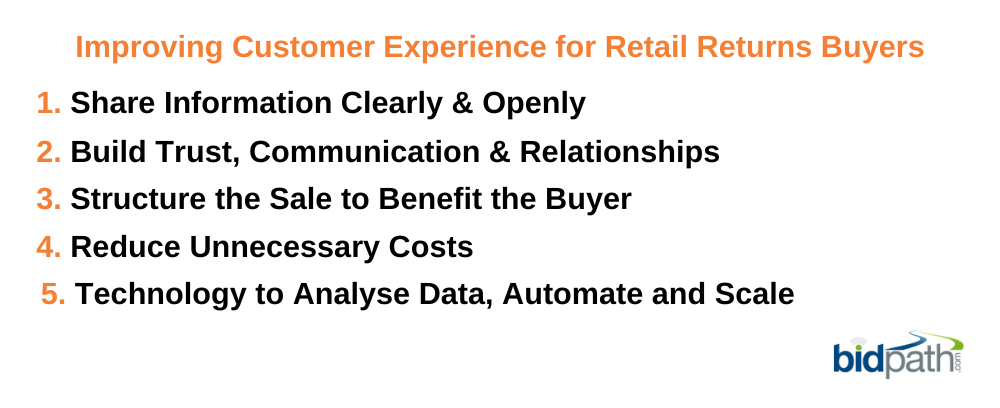Customer experience and its link to loyalty cannot be ignored. As Shep Hyken, author of The Cult of the Customer wrote in a 2023 article for Forbes; “When you recognise that a good customer experience can be the source of customer loyalty and repeat business, every moment at every touchpoint becomes an opportunity for customer service.”
Successful retailers and manufacturers around the world already embrace this belief and invest heavily into to their customer service offerings. The meteoric rise of retail giants like Amazon, Apple, and Walmart underscores the immense value of prioritizing the customer above all else in business strategy and operations.
So if we already embrace this for retail customers, what about the customers who buy our retail returns and overstock?
Why Every Buyer Matters
We put a lot of effort in keeping retail customers happy, but do we apply the same principle for retail liquidation customers? Are they different?
We already ask a lot from our buyers of retailer returns. They have to create business out of an inconsistent and variable quality stock source, and have limited choice in the volume and even breakdown of the items they’re buying. Supply is at its highest when the market demand is lowest, and vice versa. If anything, customer loyalty is even more important in retail return sales, where there is so much that can’t be controlled. Making the areas that are controllable become even more relevant.
It is understandable how this is a hard business for a seller, where stock is just as unpredictable in condition as it is in frequency. Returns and overstock may be inevitable, yet they can also represent a failure somewhere else in the system; either too much was produced, or there was no way to get the returned items back onto retailers’ shelves. We know these items are already a loss, so the question is… how much of a loss?
 How do you try and align the needs of both buyer and seller with an inconsistent supply?
How do you try and align the needs of both buyer and seller with an inconsistent supply?
Most buyers accept a fair degree of uncertainty that surrounds buying retail returns; they can deal with the inconsistency, quality lapses and supply peaks and troughs that come along, but efforts to reduce any additional impact can have a lasting effect on a customer’s buying experience.
Key concerns that buyers often have are:
Condition: Receiving items in poorer condition than expected
Items: Unpredictable pallet contents
Costs: Logistical issues like high shipping costs or delays (especially when unexpected).
Addressing these concerns can go a long way in improving customer experience and fostering loyalty. Here are some key considerations, broken down in more detail:
1. Share Information Clearly & Openly
Charges & Fees: If you plan to charge a fee on top of the sale price (e.g. a buyer’s premium in an auction sale), make it clear and up front (not buried deep in the terms). Equally, any other fees for packaging etc, make sure the buyer is made fully aware.
Transparency & Fairness: Transparency should also apply to the condition of the lots. Buyers accept that some lots will be non-functional or incomplete, but not if these characteristics come as a surprise after buying (or the volume of broken items is higher than expected). Studies have shown that openly sharing the condition of items at auction can result in higher, not lower, recovery rates.
Terms & Timings: If a sale is provisional, or there are tight timings to remove an item from site (or anything else that will affect a buyer) – make it clear and consider communicating it multiple times, and in different ways. This is especially the case as you bring in more buyers to your sales who may not be familiar with the process.
2. Build Trust, Communicate & Establish Relationships
Buyer Relationships: We work with clients moving from more manual methods like spreadsheets and emails to an automated bidding process. But many of them are understandably concerned about lapses in communication with this method; especially when they’ve worked so hard to build up relationships with these buyers. Keep in regular communication, especially with regular buyers. If you’re introducing a new system, don’t let your customers get lost in the process; ensure they can reach out to a human for help.
Cancelling Sales: While mistakes happen and sales sometimes have to be cancelled, avoid doing this at all costs as it will have a highly negative impact on loyalty. If it’s in question whether an item is available or not, then don’t sell it until you are certain, or it make it clear that it is a provisional sale or contingent on final approval.
Integrity: While the condition of retail returns packages are variable, you don’t want a buyer to feel they’ve been ‘tricked’ when they receive the items. Consider being open about items where the condition is poor/salvage or unknown, this can actually add to the credibility of other packages which are in better condition.
Feedback: Collect (and importantly respond to) feedback from your buyers about all aspects of the process. Alongside analysing data (see below), this is an important way to ensure your approach is highly tailored to your buyers.
Promote: This might seem obvious – but make sure you tell your buyers about your sales! This could be as simple as informing a restricted database of buyers that the upcoming sales are now live, or through wider promotional channels, such as your website or social media. Making sure buyers have plenty of notice to buy your items will ensure they keep coming back (especially if your sales aren’t regular or consistent).
3. Structure the Sale to Benefit the Buyer
Smaller Packages of Items: Smaller packages can make sales more accessible to a wider range of buyers. While it may not be possible to break down if you’re dealing in multiple truckloads every day, it’s worth analyzing your sales to see where it is worth breaking down further. Don’t go too far though - there is an optimum level of effort and reward to break down packages. We analysed auction lot sizes vs recovery in electronics and found that the value per item increased as the lot size neared to 10 items, but there was no increase beyond that for smaller lots.
Selective Package Contents: If you ever watch videos online of buyers unpacking liquidation pallets, you’ll quickly see the excitement around finding that one ‘hidden gem’. Don’t be tempted to cherry pick all the high value items from mixed pallets; keep the chance for a buyer to find one and they’ll be sure to come back. This doesn’t mean you have to lose money on some pallets – just remember the buyer will have a higher expected value on certain items (based on the resale price) than the expected recovery rate.
Competitive Bidding: While you might think that buyers would love an non-competitive process, this is not the case. Many buyers stop bidding if they don’t ever win a package, which means eventually a small number of buyers start winning every item (and don’t have a reason to stay competitive). Introducing a competitive process with a visible bid price (like an auction) gives each buyer instant feedback as to whether they’re winning a package or not, and gives them an incentive to bid again.
Consistent Sales: While the availability of stock is always going to be seasonal, try to spread it out if you can. One sale a week for several months may be more effective than one large event. This fosters loyalty – buyers come back when they know more items are on the way.
4. Reduce Unnecessary Costs
Collection Delays: If a buyer’s transport provider has to wait on site (or even worse, can’t collect at all on the intended date), this will significantly add to their costs. Consider a calendar booking system for collections and ensure a member of your team is prepared to receive customers and minimise delays.
Item Availability: If there is something that could hinder the collection of a sold item, consider carefully whether it should be sold yet. If a buyer is expecting to collect a purchase (and therefore isn’t looking around to procure alternatives) that is delayed several weeks, this could have a knock-on effect on their return for future sales.
Shipping Costs: While it is common for shipping or collection to be the responsibility of the buyer, look at ways you can keep the costs to a minimum. Are items palletised, and if not could/should they be? For smaller items, can you provide packing materials that would allow couriers to collect? Unexpected costs in shipping can make the difference between a package being profitable for a buyer or not.

5. Use Technology to Analyse Data, Automate and Scale
Use and Respond to Analytics: We refer to package size above and how to optimise for recovery rates – but the best approach will be particular to what you sell, how you sell it, and what your buyers prefer. Look at the data produced by the systems you use to sell retail returns. What gets the best response? Where are the recovery rates highest? Use this to experiment with different approaches.
Automate: While the need for the human touch is important, automating repeatable tasks is a way of freeing up time, so your team can concentrate on what matters. Consider implementing a system that will inform buyers of new stock, confirmed bids, outbid notices and other key updates.
Scale: While automation can allow you to move higher volume through your systems, it can also enable you to expand the number of single items you sell by breaking down your existing packages. Combined with analysis of your data, this can lead to increased recovery rates without excessive additional work.
Conclusion
It can be difficult to align the different needs of buyers and sellers when selling retail returns. There are always unknown factors like condition and inconsistency in supply, and some of them can’t be resolved. This makes driving buyer loyalty through a positive customer experience tricky. However, being open and transparent, communicating effectively and working to structure sale items in a way that benefits a wider range of buyers can result in a more positive experience for the buyers of retail returns, and lead to a loyal buyer group that returns again and again. The application of technology to refine your approach and automate repeatable tasks will give you back the time for actions that will have a positive effect on recovery rates while further improving the buyer experience.
Dan Main (dmain@bidpath.com) is a director at Bidpath, we provide white label auction platforms for retailers, manufacturers and auctioneers. Dan has worked closely with retailers, manufacturers, government agencies and financial institutions over the last 18 years to help evaluate surplus assets and design and implement strategies to optimise their resale. He has helped find new homes for items as diverse as military Humvees, the microphone used to record The Queen’s Christmas Day message, and $10 million of audio-visual equipment. He lives in Cornwall, UK with his wife Salena and 1000 house plants.